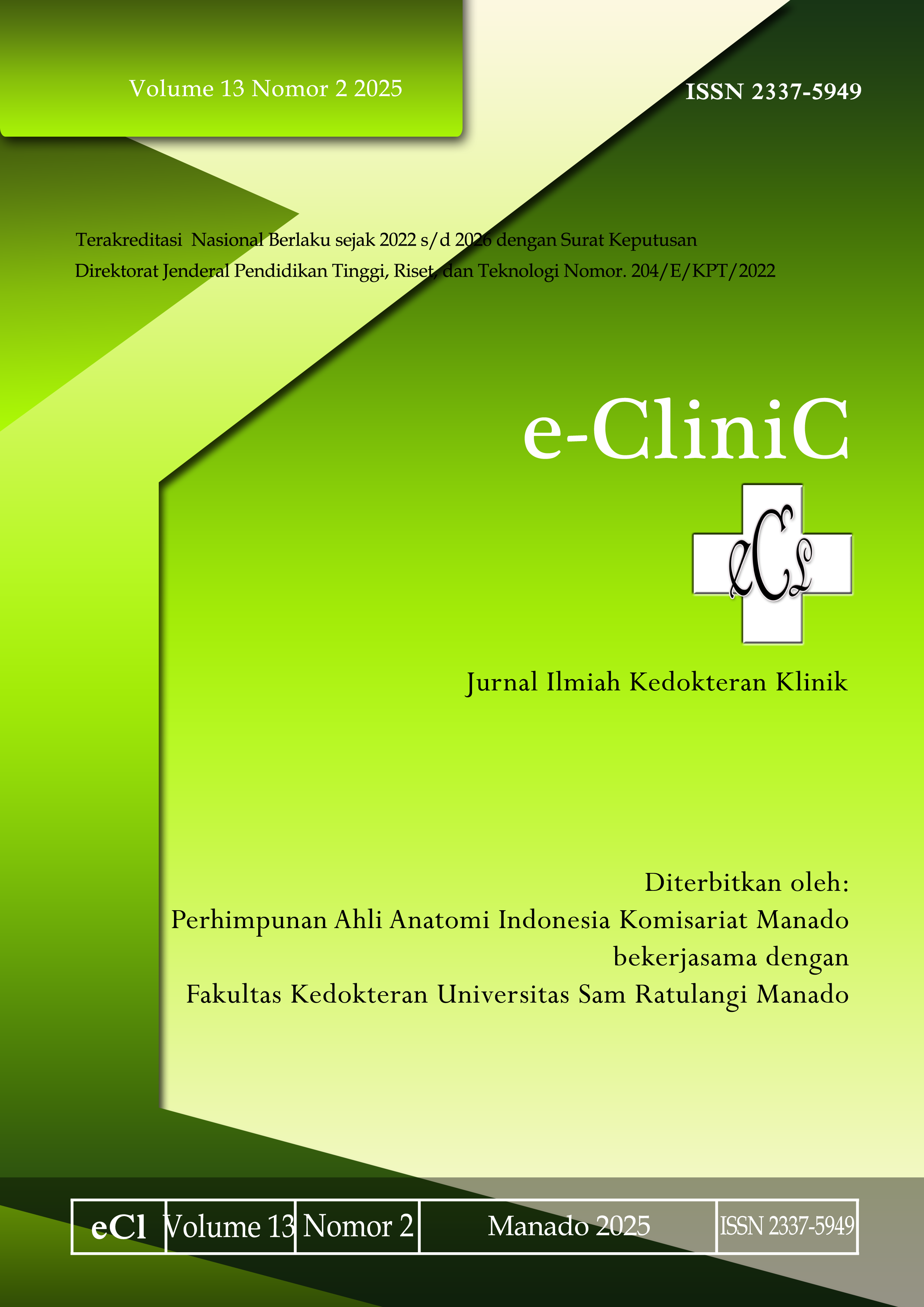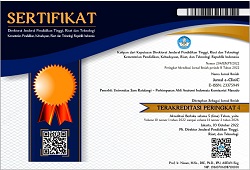Perbandingan Rasio FEV1/FVC pada Perokok Elektronik dan Perokok Tembakau Mahasiswa Universitas Sam Ratulangi
DOI:
https://doi.org/10.35790/ecl.v13i2.61016Abstract
Abstract: Smoking can accelerate decrease of lung function due to the abundant harmful substances in cigarettes. Decreased lung function is characterized by a decrease in the values of forced expiratory volume 1 (FEV1), forced vital capacity (FVC), and FEV1/FVC ratio. This study aimed to compare the FEV1/FVC ratio in electronic smokers and tobacco smokers among students of Universitas Sam Ratulangi. This was a quantitative study using analytical and observational method with a cross-sectional design. Samples were students of the Faculty of Engineering Class 2021, Department of Electrical Engineering, Universitas Sam Ratulangi, obtained by using the purposive sampling method. There were 51 male students as respondents. The Mann-Whitney test on the FEV1/FVC ratio obtained a p-value of 0.022 (2-tailed) (<0.05). In conclusion, there is a significant difference in the FEV1/FVC ratio between electronic smokers and tobacco smokers.
Keywords: ratio of FEV1/FVC; electronic smoker; tobacco smoker;
Abstrak: Merokok dapat mempercepat penurunan fungsi paru akibat mengandung banyak zat berbahaya. Penurunan fungsi paru ditandai dengan penurunan nilai forced expiratory volume 1 (FEV1), forced vital capacity (FVC), dan penurunan rasio FEV1/FVC. Penelitian ini bertujuan untuk mengetahui perbandingan rasio FEV1/FVC pada perokok elektronik dan perokok tembakau mahasiswa Universitas Sam Ratulangi. Jenis penelitian ini ialah kuantitatif yang menggunakan metode penelitian observasional analitik dengan desain potong lintang. Sampel penelitian ialah mahasiswa Fakultas Teknik Angkatan 2021 Jurusan Teknik Elektro Universitas Sam Ratulangi, diperoleh dengan metode purposive sampling. Hasil penelitian mendapatkan 51 mahasiswa laki-laki sebagai responden penelitian. Hasil uji Mann-Whitney terhadap FEV1/FVC pada perokok tembakau dan perokok elektronik mendapatkan nilai p=0,22 (2-tailed) (p<0,05). Simpulan penelitian ini ialah terdapat perbedaan bermakna pada rasio FEV1/FVC antara perokok elektronik dan perokok tembakau.
Kata kunci: rasio FEV1/FVC; perokok elektronik; perokok tembakau
References
Tobacco. World Health Organization (WHO). 2023 [cited 2023 Aug 29]. Available from: https://www.who.int/news-room/fact-sheets/detail/tobacco
Apa itu rokok? Kementerian Kesehatan Republik Indonesia. 2018 [cited 2023 Aug 29]. Available from: https://p2ptm.kemkes.go.id/preview/infografhic/apa-itu-rokok
Prevalence. The Tobacco Atlas. 2022 May 22 [cited 2023 Aug 29]. Available from: https://tobaccoatlas.org/ challenges/prevalence/
Daniati TBA, Juliansyah E, Sohibun. Faktor-faktor yang berhubungan dengan perilaku merokok pada remaja di Kelurahan Kapuas Kanan Hulu Kecamatan Sintang Kabupaten Sintang. Jurnal Kesehatan Masyarakat. 2022;1(1):2–10. Available from: https://doi.org/10.33143/jhtm.v7i2.1575
Salsabila NN, Indraswari N, Sujatmiko B. Gambaran kebiasaan merokok di Indonesia berdasarkan Indonesia Family Life Survey 5 (IFLS 5). Jurnal Ekonomi Kesehatan Indonesia. 2022;7(1):4–9. Doi: http://dx.doi.org/10.7454/eki.v7i1.5394
Ripsidasiona, Ahmad FA. Perokok dewasa di Indonesia meningkat dalam sepuluh tahun terakhir. Kementerian Kesehatan Republik Indonesia. 2022 [cited 2023 Aug 29]. Available from: https://www.badankebijakan.kemkes.go.id/perokok-dewasa-di-indonesia-meningkat-dalam-sepuluh-tahun-terakhir/
Badan Pusat Statistik Provinsi Sulawesi Utara. 2021 [cited 2023 Sep 4]. Available from: https://sulut.bps.go.id/indicator/30/506/1/persentase-penduduk-laki-laki-berumur-5-tahun-ke-atas-menurut-kabupaten-kota-dan-karakteristik-merokok-tembakau.html
Suryadinata RV, Lorensa A. Studi risiko gangguan fungsi paru terhadap perokok di kalangan remaja. Indonesian Journal of Professional Nursing. 2023;4(1):1–7. Doi: http://dx.doi.org/10.30587/ijpn.v4i1.5489
Natalie V, Lontoh SO. Perbandingan fungsi paru antara mahasiswa perokok dan bukan perokok di Fakultas Teknik Universitas Tarumanagara. Tarumanagara Medical Journal. 2020;2(1):167–72. Doi: https://doi.org/10.24912/tmj.v2i2.7857
Münzel T, Hahad O, Kuntic M, Keaney JF, Deanfield JE, Daiber A. Effects of tobacco cigarettes, e-cigarettes, and waterpipe smoking on endothelial function and clinical outcomes. Eur Heart J. 2020;41(41):4057–70. Doi: https://doi.org/10.1093/eurheartj/ehaa460
Sudradjat SE. Kajian efek rokok elektrik terhadap kesehatan. Jurnal Kedokteran Meditek. 2019;25(3):115–7. Doi: https://dx.doi.org/10.36452/jkdoktmeditek.v25i3.1775
Shmerling RH. Can vaping damage your lungs? What we do (and don’t) know. Harvard Health Publishing. [cited 2023 Aug 29]. Available from: https://www.health.harvard.edu/blog/can-vaping-damage-your-lungs-what-we-do-and-dont-know-2019090417734
Quick facts on the risks of e-cigarettes for kids, teens, and young adults. Center for Chronic Disease Prevention and Health Promotion . 2022 [cited 2023 Aug 29]. Available from: https://www. cdc.gov/tobacco/basic_information/e-cigarettes/Quick-Facts-on-the-Risks-of-E-cigarettes-for-Kids-Teens-and-Young-Adults.html?s_cid=OSH_emg_GL0004&gclid=Cj0KCQjw84anBhCtARIsAISI-xfHJJn9GPuIx-bvzjI4v_HizAcfZfVFZdkjjZETtc3lf_YKvxZRuIcaAkXjEALw_wcB#why-is-nicotine-unsafe)
Pitoy EL, Boki H. Hubungan antara lama bekerja dan kebiasaan merokok dengan kapasitas vital paru pada polisi lalu lintas kepolisian resort Kota Manado. Jurnal Kesmas. 2018;7(5):1–6. Available from: https://ejournal.unsrat.ac.id/index.php/kesmas/article/view/22631
Ahkami A, Amalia R, Hayati. Analisa nilai kapasitas pernapasan maksimal (KPM) mahasiswa perokok pasif di Universitas PGRI Adi Buana Surabaya. Jurnal Wahana Universitas PGRI Adi Buana Surabaya. 2022;74(1):5–8. Doi: https://doi.org/10.36456/wahana.v74i1.5676
Jatmiko ID, Arbaningsih SR. Perbedaan faal paru antara perokok tembakau dengan perokok elektronik di komunitas Pakam Region Vaporizer. Jurnal Ilmiah Kohesi. 2021;5(4):12–9. Available from: https://kohesi.sciencemakarioz.org/index.php/JIK/article/view/303
Ukoli CO, Joseph DE, Durosinmi MA. Peak expiratory flow rate in cigarette smokers. Highland Medical Research Journal. 2002;1(2):36–7. Doi: https://doi.org/10.4314/hmrj.v1i2.33805
Nighute S, Buge K, Kumar S. Effect of cigarette smoking on peak expiratory flow rate: a short review. International Journal of Current Research in Physiology and Pharmacology. 2017;1(1):3–5. Available from: https://www.ijcrpp.com/index.php/ijcrpp/article/view/19
Rudy AK, Leventhal AM, Goldenson NI, Eissenberg T. Assessing electronic cigarette effects and regulatory impact: challenges with user self-reported device power. Drug and Alcohol Dependence. 2017;179:337–40. Doi: https://doi.org/10.1016/j.drugalcdep.2017.07.031
Aulya R, Herbawani CK. Hubungan antara tingkat pengetahuan tentang rokok terhadap perilaku merokok pada remaja di SMP X. Jurnal Kesehatan Masyarakat Prepotif. 2019;6(1):983–90. Doi: http://dx.doi.org/ 10.31004/prepotif.v6i1.2961
Muslih RN, Alie IR, Irasanti SN. Perbedaan nilai FEV1 dan FVC antara perokok putih dan perokok elektrik pada remaja di Kota Bandung. Prosiding Pendidikan Dokter. 2018;5(1):298–305. Available from: https://doi.org/10.31004/pdk.v4i4.6032
Downloads
Published
How to Cite
Issue
Section
License
Copyright (c) 2025 Trinita E. Marasi, Ivonny M. Sapulete, Joice N. A. Engka

This work is licensed under a Creative Commons Attribution-NonCommercial 4.0 International License.
COPYRIGHT
Authors who publish with this journal agree to the following terms:
Authors hold their copyright and grant this journal the privilege of first publication, with the work simultaneously licensed under a Creative Commons Attribution License that permits others to impart the work with an acknowledgment of the work's origin and initial publication by this journal.
Authors can enter into separate or additional contractual arrangements for the non-exclusive distribution of the journal's published version of the work (for example, post it to an institutional repository or publish it in a book), with an acknowledgment of its underlying publication in this journal.
Authors are permitted and encouraged to post their work online (for example, in institutional repositories or on their website) as it can lead to productive exchanges, as well as earlier and greater citation of the published work (See The Effect of Open Access).







